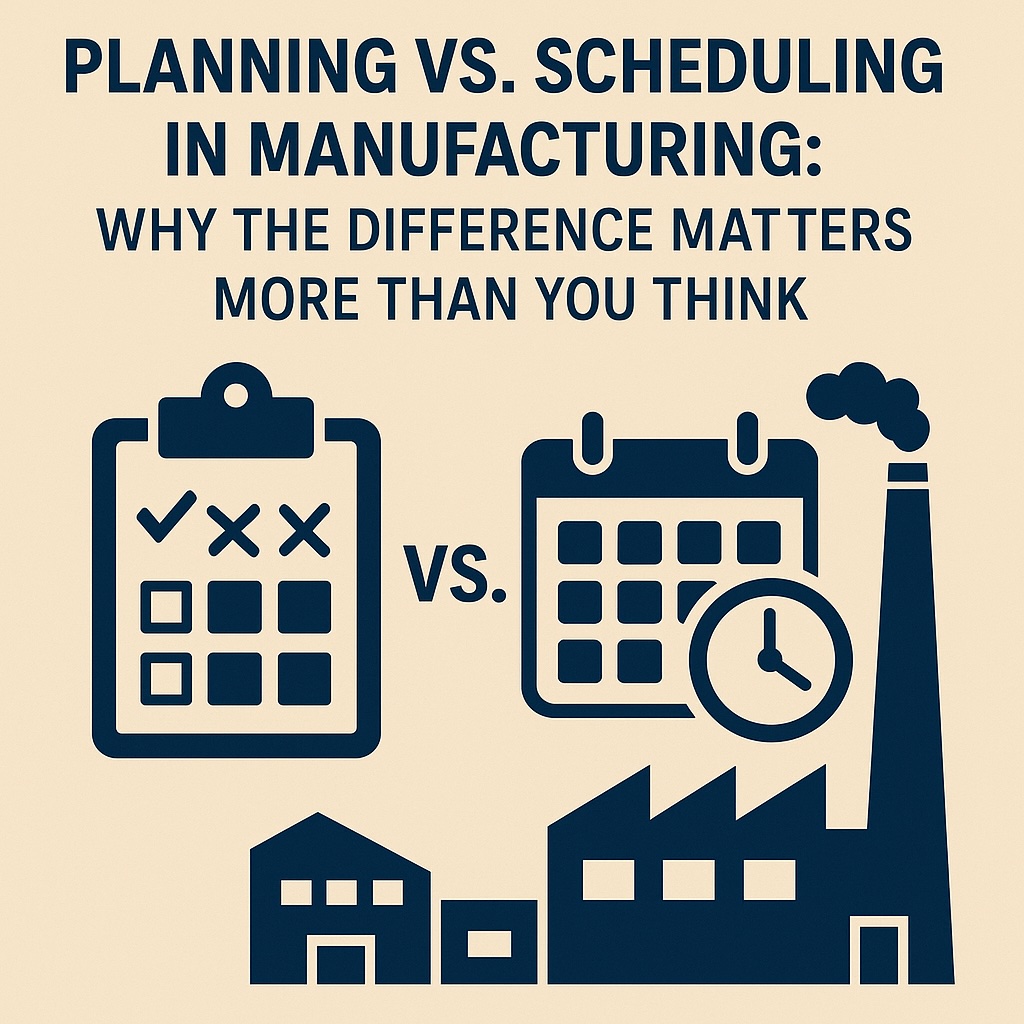Planning vs Scheduling in Manufacturing: Why the Difference Matters More Than You Think

Introduction: Stop Confusing Planning with Scheduling
In manufacturing, planning and scheduling are two words often used interchangeably. But they’re not the same — and confusing them leads to serious problems:
- Missed delivery dates
- Overloaded work centers
- Idle machines or people
- Firefighting on the shop floor
To run an efficient operation, you need to understand the difference between what you plan and how you schedule it.
In this article, we’ll explain:
- The difference between production planning and scheduling
- Where tools like MPS, MRP, and MES fit in
- How factory.online connects both sides of the equation
- Why getting this right improves delivery, efficiency, and flexibility
Planning vs Scheduling: The Core Difference
Planning
- Time Horizon: Mid to long term (weeks/months)
- Purpose: Assess feasibility, prepare resources
- Data Used: Forecasts, orders, capacities
- Tools Involved: MRP, MPS, RCCP
- Output: Production plan (what to make, when)
Scheduling
- Time Horizon: Short term (hours/days)
- Purpose: Coordinate execution on the floor
- Data Used: Job orders, resource availability
- Tools Involved: MES, APS, dispatch lists
- Output: Job sequence (who does what, when)
Think of planning as your strategy, and scheduling as the tactics that make it real.
What is Production Planning?
Production planning is about answering:
“Can we meet future demand with our current materials, machines, and labor?”
It includes several layers:
- MPS (Master Production Scheduling): Converts forecasts and sales orders into production timelines
- MRP (Material Requirements Planning): Determines what materials are needed and whe
- RCCP (Rough-Cut Capacity Planning): Validates whether you have the resources to meet the MPS
These tools help you:
- Align with customer demand
- Avoid overloading your factory
- Identify material or resource gaps earl
- Set the stage for efficient execution
But they don’t tell you which operator runs which machine at what time.
That’s where scheduling comes in.
What is Production Scheduling?
Scheduling turns your production plan into a real-world action list.
It answers:
“What operation happens next, on which machine, with what priority?”
Scheduling includes:
- Assigning job orders (MOs) to specific work centers
- Sequencing operations based on setup time, delivery urgency, or dependencies
- Reacting to changes (e.g., machine breakdowns, urgent orders, operator absence)
It’s much more detailed than planning and happens closer to execution — often day-by-day or shift-by-shift.
Why the Difference Matters
Without understanding the distinction between planning and scheduling, you get:
- ❌ Plans that aren’t executable
- ❌ Schedules that ignore constraints
- ❌ Missed deadlines and unbalanced workloads
- ❌ Confusion between departments (sales, planning, operations)
When properly aligned, planning and scheduling work together like this:
- Planning defines a feasible path based on demand and resource availability
- Scheduling breaks that path into executable job steps
- Execution (MES) monitors job progress in real time
Feedback from MES helps re-plan or re-schedule when needed.
Where factory.online Fits In
factory.online connects both sides of the planning/scheduling process in one system.
Planning Layer
Includes:
- MPS to turn forecasts into a rolling production plan
- MRP to calculate raw material needs
- RCCP to check machine and labor availability
- What-if scenarios to model changes before they happen
Scheduling Layer
Includes:
- Job Order generation from approved MO
- Automatic assignment of jobs to machines or operators
- Gantt-style visual schedules
- Changeover-aware sequencing
- Real-time adjustment based on actual conditions
Execution Layer (MES)
Includes:
- Operator dashboards
- Job status tracking (in progress, delayed, completed)
- Downtime logging
- Integration with quality checks, maintenance, and material movements
The result: Your plan reflects reality, and your schedule stays adaptable.
Example: Planning Without Scheduling = Risk
You’ve planned to produce 5,000 units of Product A next week.
Your MPS and RCCP say it’s possible.
But:
- You forgot to account for a machine that’s under maintenance
- You didn’t factor in a 3-hour setup between jobs
- An urgent customer order was accepted but not sequenced first
The result?
- The plan looked fine — but execution failed
- You missed your delivery window
- Operators worked overtime to catch up
This is why finite scheduling tools are just as critical as MRP or RCCP.
Scheduling Challenges That factory.online Solves
- Overlapping priorities: Schedules jobs by priority, due date, or rule-based logic
- Changeovers: Minimizes setup times using product attributes and changeover matrices
- Work center overloads: Balances load across available machines or alternative routings
- Rush orders: Inserts urgent jobs dynamically without breaking the schedule
- Breakdowns or operator absence: Reroutes operations based on live shop floor status
Planning and Scheduling Must Work Together — Not in Silos
Problems
- Late orders
- Root Cause: No scheduling priority applied
- factory.online Fix: Real-time job sequencing
- Long lead times
- Root Cause: Inaccurate capacity planning
- factory.online Fix: RCCP + finite scheduling integration
- Root Cause: Inaccurate capacity planning
- Production firefighting
- Root Cause: No real-time feedback loop
- factory.online Fix: Live execution visibility
- Wasted setups
- Root Cause: Inefficient operation grouping
- factory.online Fix: Changeover-optimized scheduling
In factory.online, scheduling isn’t a separate module — it’s part of the same system that handles planning and execution.
Real-World Impact: Automotive Component Supplier
A Tier 2 supplier for automotive parts used factory.online to align their planning and scheduling layers.
After 60 days:
- Reduced rescheduling events by 35%
- Increased on-time delivery from 82% to 96%
- Cut setup-related downtime by 22%
Improved planner-operator communication via shared dashboards.
Final Thoughts: Stop Planning in Isolation
Planning without scheduling is like building a house with no construction crew.
Scheduling without planning is like trying to build the roof before the foundation.
With factory.online, you get a fully integrated approach:
- Strategic planning throughMPS, MRP, and RCCP
- Operational execution through job-level scheduling
- Real-time visibility throughMES integration
- Scenario simulations to adapt before problems arise
Next Steps
Ready to unify your planning and scheduling?
- Start your free trial — simulate your plan and schedule in one place
- Book a demo — see real-time job sequencing and load balancing
- Talk to an expert — get advice on syncing your team’s workflow


.svg)
.svg)
.svg)
.svg)